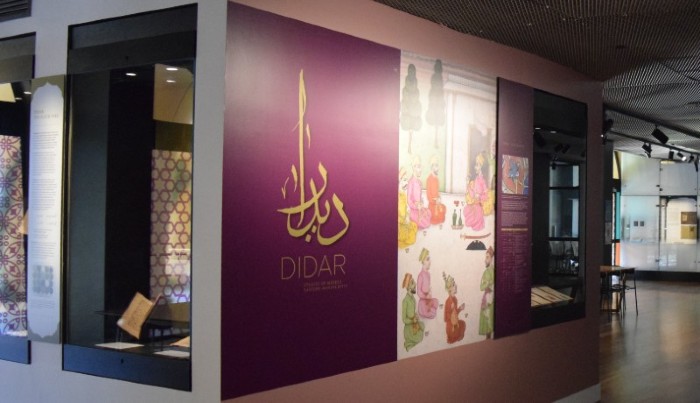Didar exhibition of Middle Eastern manuscripts opens in Arts West Gallery

The DIDAR exhibition, a curated selection of some of the University of Melbourne’s extraordinary Middle Eastern manuscript collection, is now on display at the Arts West Gallery.
The collection holds 168 volumes – not a large collection when compared with the great libraries of the Near and Middle East, but a significant collection in Australia.
DIDAR has been co-curated by Sophie Lewincamp and Leila Alhagh, current and recent PhD candidates at the University of Melbourne’s Grimwade Centre for Cultural Materials Conservation, with Dr Sadra Zekrgoo, who received his PhD in 2018. The result of years of research and combined expertise in collection care, Islamic art, paper conservation, and Persian writing inks, the exhibition showcases not only these rare and beautiful manuscripts, but the passion and skill of the Grimwade Centre’s researchers.
The curators are excited to be able to bring light to these manuscripts, and to share them with University staff, students, and members of the community.
“We were keen to translate academic research into a medium that can be accessed, used and interpreted by community members and our university community,” says Alhagh. “This is an important aspect as it contributes to preservation of intangible aspects of these manuscripts and bring these manuscripts to life.”
Comprising manuscripts in Arabic and Persian, as well as Turkish, Urdu, Ethiopic, Syriac, Hebrew, Sanskirt, Pushtu, Prakit and Mongol scripts, the collection includes Islamic religious texts, Qur’ans and commentary on the Qur’an, as well as significant poetic works, educational textbooks and writing on history, biography, astrology, mathematics, philosophy and weaponry.

Copy of Gulistan (The Rose Garden), a collection of poems and stories, which was written in 1253 by the well-known Persian poet, Sa’di. Ahmad ‘Ali transcribed the text in 1836 for Charles Marriot Caldecott, an English collector. UniM Bail SpC/BX MUL 59
“The collection covers a broad range of topics in many different languages, dating from the 14th to 19th centuries,” says Lewincamp. “There is something for everyone.”
Her favourite manuscript, though, is MUL 33, titled Multaqā al-ʾAbḥur (the meeting point of the oceans of knowledge).
“I’m drawn to the beautiful handmade papers and the way they have been prepared for calligraphy and illumination by sizing, dying and burnishing,” she says. “This manuscript features the three-crescent watermark, tre lune. It is believed to have been made by Italian papermakers for the Arab market and used widely in the Chanceries of the Ottoman Empire in the sixteenth to eighteenth centuries. It’s a cool story of trade of materials; papers made in Italy travelling to the Near East to be polished, cut and sewn into a manuscript.”
Both Lewincamp and Alhagh found curating the exhibition to be incredibly valuable and rewarding.
Alhagh describes the experience of working with fellow students to bring the exhibition to life as “nurturing”. “I learnt a lot during the design and production of the exhibition,” she says, “and I have been given the opportunity to talk to my fellow students, learn from them and share what I have learnt so far.”
Lewincamp agrees.
“It was a great experience collaborating with Leila again as well as Grimwade masters students and fellow manuscript researcher Dr Sadra Zekgroo,” she says. “We are excited too for the new collaborations the exhibition will bring.”
DIDAR is open at the Arts West Gallery from Monday – Friday, 10am – 4pm.